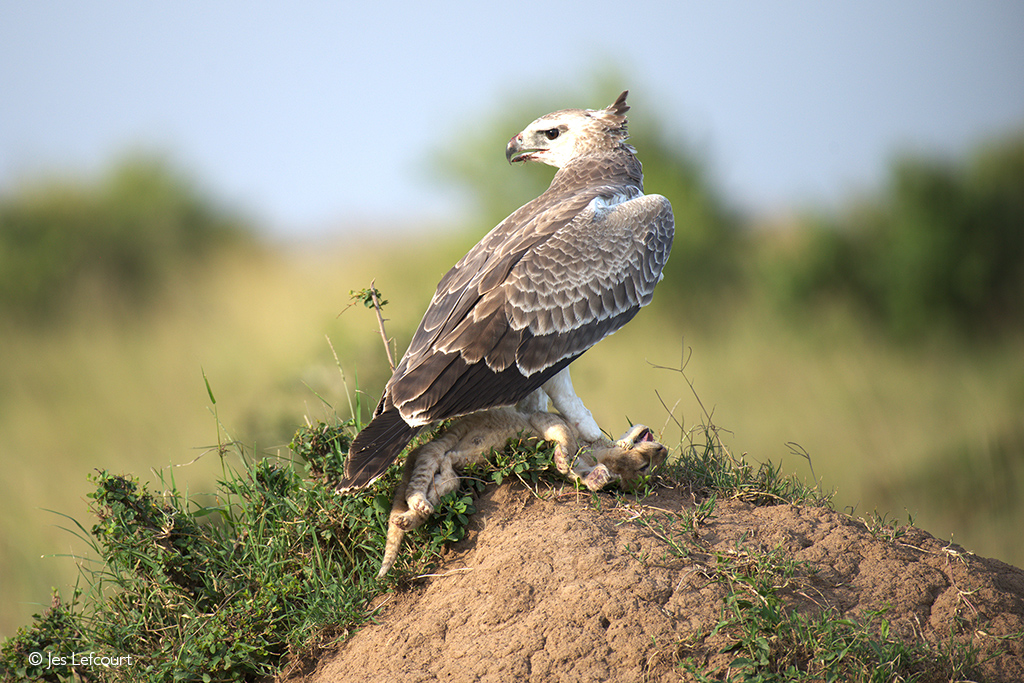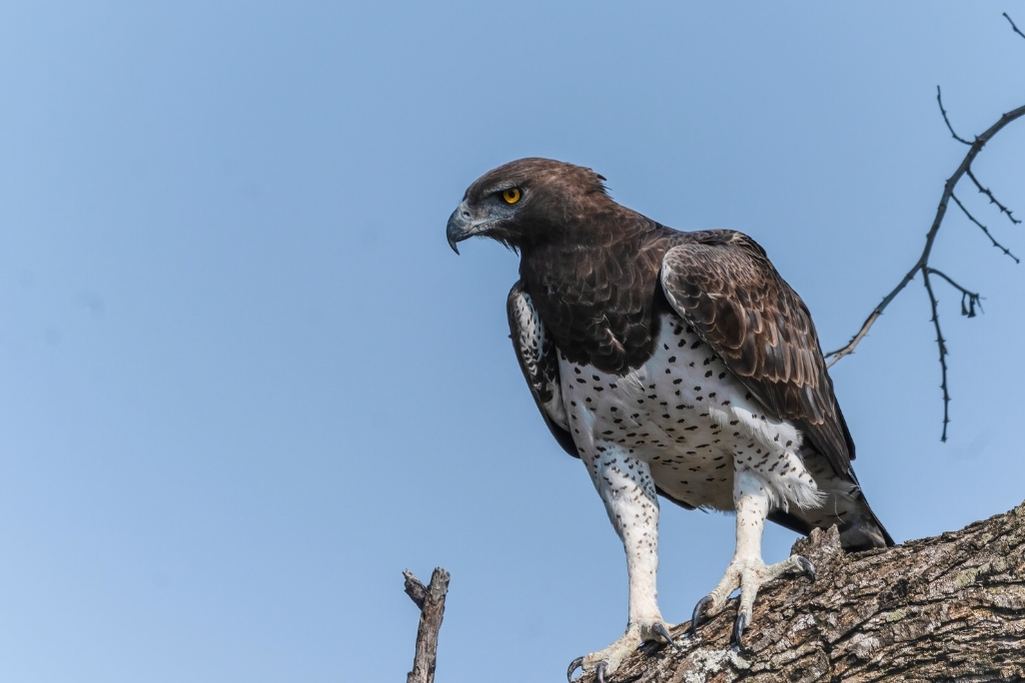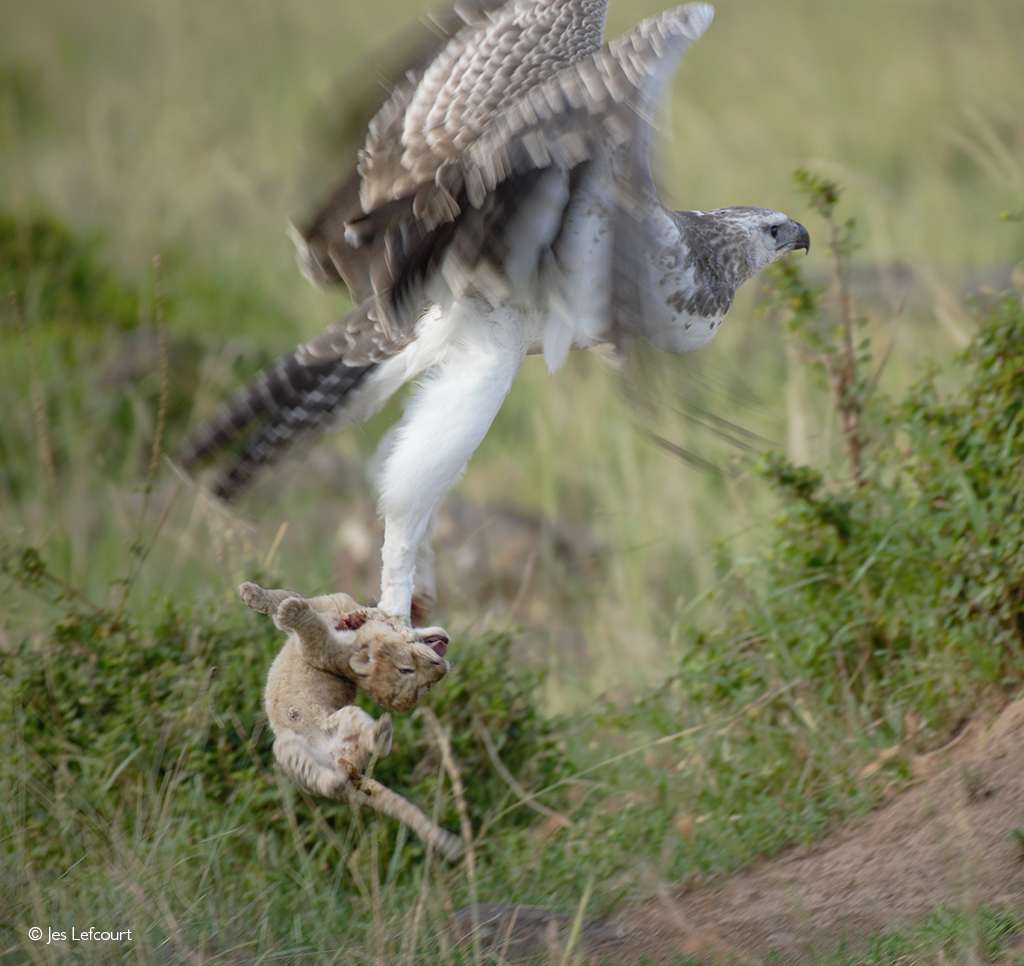
The martial eagle is Africa’s largest bird of prey. They can take down animals nearly twice their weight. A new study reveals how these formidable predators hunt and kill lion cubs in the greater Mara region of southwestern Kenya.
Martial eagles are known to have a highly varied diet, hunting anything from tiny winged termite alates erupting from holes in the ground after a thunderstorm to antelopes weighing 10kg (22lbs) or more.
In a new study, researchers have gathered together all the records made since 2008 of what appears to be the opportunistic hunting of lion cubs weighing up to 6kg (13lbs) by martial eagles in the greater Mara region of southwestern Kenya.
Female martial eagles are bigger than the males, and they are likely the ones hunting lion cubs simply because they’re able to fly off to safety with heavier prey, says PhD candidate and corresponding author of the study, Richard Stratton Hatfield. Also, it’s the female martial eagles who prefer to eat mammals, he says.

“Males tend to really like [hunting] birds, and so I just think a lion cub is really more on the menu for a female.”
It is hard to tell male and female martial eagles apart from photographs, says Hatfield, but based on their body and talon size, all of the eagles photographed and recorded hunting lion cubs appear to be females.
In 2016, Hatfield began studying these apex predators – these distinctively long-winged soaring eagles with piercing yellow eyes and white breasts flecked with dark spots – for his Master’s thesis. He discovered the birds captured around 50 different species of prey. But it was Simon Thomsett, a leading authority on East African birds of prey, who would also become Hatfield’s co-author on the study, who first told him about a pair of martial eagles hunting lion cubs at the Musiara Marsh, within the Maasai Mara National Reserve.

“It’s well known in guiding lore in the Mara that martials can take lion cubs,” Hatfield says. In all, his study documents a total of nine lion cubs killed by martial eagles between August 2008 and June 2023.
In one notable record, field guide and camp manager Patrick Reynolds and his team documented a martial eagle, probably the same individual, hunting all three cubs from a pride near the Musiara Marsh over several weeks in December 2012.

In another incident, Mike Saitoti from Fairmont Safari Club observed and photographed a young martial eagle killing a lion cub in the Lemek Conservancy, in the north of the reserve. The cub was too heavy for the young eagle to carry, so it dragged it to a nearby termite mound to feed in peace.
But lion cubs aren’t always easy prey. The study cites a video by Mark Mallone in the Mara North Conservancy in 2016 that captured the moment a martial eagle attempted to take a six-week-old lion cub. The video depicts how the eagle was thwarted by a protective lioness that leapt into the air to try to swat the eagle.
“They’re clever; they’re not going to kill things that are unnecessarily dangerous,” he says. “It’s all about managing risk and reward, and also what they can fly with. It almost becomes a liability if they can’t fly with [the prey].”
The greater Mara region is rich in wildlife, including lions, and consequently closely monitored by safari guides and their clients. However, the martial eagle’s range extends across large parts of East and Southern Africa, meaning similar encounters could be happening elsewhere but have yet to be recorded.
 Want to visit the Mara region on an African safari? Check out Maasai Mara safaris here, or let our travel experts plan the perfect African safari for you by clicking here
Want to visit the Mara region on an African safari? Check out Maasai Mara safaris here, or let our travel experts plan the perfect African safari for you by clicking here
“These predation events are probably rare but widespread and underreported in literature,” Hatfield and his co-authors state. They also list several isolated records in the past of martial eagles killing other mammalian carnivores and their young, including a serval in Uganda’s Queen Elizabeth National Park, a cheetah cub in Kenya’s Amboseli National Park, and an African wild dog pup in South Africa’s Klaserie Private Nature Reserve.
Hatfield, who also works on conservation programmes in southern Kenya with the Kenya Bird of Prey Trust, says he hopes his research on lion-cub hunting will present martial eagles in a new light – as “a predator of consequence” – something that is too often overlooked in studies of predator-prey relationships in African savannah systems.
“Raptors in general, and definitely martial eagles, are just completely excluded from the equation,” he says. “The top of a trophic [food] pyramid is much more complicated than we realise, and it’s not as simple as ‘lions are the king of the jungle’.”

The researcher says that recognition that martial eagles occupy a place alongside lions, leopards, and hyenas at the top table would help boost the eagles’ conservation value. The birds, along with other large African raptors, need all the conservation help they can get.
A separate study published earlier this year analysed declines in dozens of birds of prey across Africa over the past 20–40 years. It found that the number of martial eagles was down by 90%.
For Kenyan martial eagles, this is driven in large part by the shrinking of suitable habitat needed to sustain breeding pairs and their offspring, which are often electrocuted on power cables when they disperse from the safety of their parents’ territory. “Just like lions, they probably don’t have a future outside of our large protected areas,” says Hatfield.
Further reading
African eagles soar through the skies, sharp-eyed and fierce, bringing unexpected death from above to their prey. Read more about the avian apex predators of Africa here.
To comment on this story: Login (or sign up) to our app here - it's a troll-free safe place 🙂.![]()






